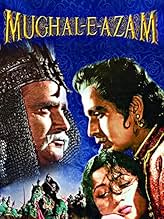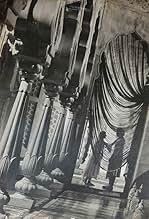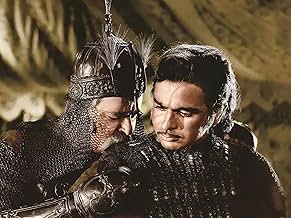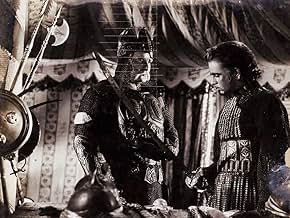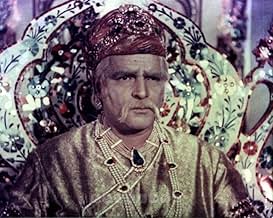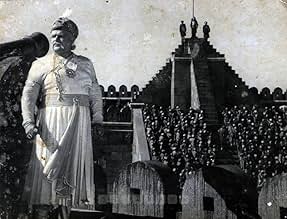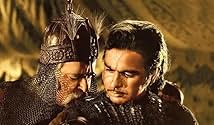VALUTAZIONE IMDb
8,1/10
9295
LA TUA VALUTAZIONE
Ambientato alla fine del XVI secolo nel periodo Moghul dell'India, questa è la vita sfortunata del principe Saleem, figlio dell'imperatore regnante Akbar, che si innamora della schiava danza... Leggi tuttoAmbientato alla fine del XVI secolo nel periodo Moghul dell'India, questa è la vita sfortunata del principe Saleem, figlio dell'imperatore regnante Akbar, che si innamora della schiava danzante Anarkali.Ambientato alla fine del XVI secolo nel periodo Moghul dell'India, questa è la vita sfortunata del principe Saleem, figlio dell'imperatore regnante Akbar, che si innamora della schiava danzante Anarkali.
- Premi
- 3 vittorie e 3 candidature totali
Prithviraj Kapoor
- Emperor Akbar
- (as Prithviraj)
Ajit Khan
- Durjan Singh
- (as Ajit)
Jillo
- Anarkali's Mother
- (as Jillo Bai)
Sheila Dalaya
- Suraiya
- (as Sheela Delaya)
Tabassum Govil
- A Tawaif
- (as Baby Tabassum)
Recensioni in evidenza
10veeru
Haha -- when I see comments that put Kuch Kuch Hota Hain or any other formulaic hindi flick as "the best film ever" they obviously didn't see K. Asif's vision of Mughal-e-Azam. From Prithviraj Kapoor's magnificent rendering of the imposing Emperor Akbar to Dalip Kumar's obvious love for the spectacular Madhubhala. The exquisite Urdu dialogues is of course not for the neophyte. But for those that can appreciate the finer things in life -- not some cloying Hum Apke Hain Kaun or Shah Rukh Khan's obsession with bleeding and overacting in every single film -- Mughal-e-Azam fits the bill perfectly.
The ostentatious look, the unforgettable music, the awesome war scenes, superb performances, the well-known romance between Salim and Anarkalis MUGHAL-E-AZAM will always remain as a point of reference.
After 44 years, this masterpiece has been released after reviving it in color (the original version was 85 percent black and white and 15 percent colour), with an upgraded, contemporary sound system (Dolby Digital).
The Story is about the Ruler Akbar (Prithviraj Kapoor) and Queen Jodha (Durga Khote) give birth to a son, Salim, after years of prayer.
Prince Salim (Dilip Kumar) grows into a commendable combatant. Salim falls in love with court dancer Anarkali (Madhubala). Initially wary of his affections because of the difference in their positions, she soon reciprocates his love.
Akbar finds out about the affair and that creates a rift between the father and son.
It is a must see movie for every moviegoer for its pure canvass, for its majestic framing and not just for being a colorful costume drama, for its romance, for the glorious Sheesh Mahal and also for our fake filmmakers (like karan johar, aditya chopra, nikhil advani, kunal kohli and many others like them) who cannot think beyond Manhattan and singing heroes and have light years to reach this level of film-making.
MUGHAL-E-AZAM is a must for those who have seen it in B & W. Now watch it in color and experience the grandeur. MUGHAL-E-AZAM is a must for todays generation, who, perhaps, may not have watched this classic. Watch this epic and you will realize the difference between the cinema of yore and the cinema of today. MUGHAL-E-AZAM is a must for every moviegoer. Here is a prime example of pure, unadulterated cinema. 4 ½ Out of 5
After 44 years, this masterpiece has been released after reviving it in color (the original version was 85 percent black and white and 15 percent colour), with an upgraded, contemporary sound system (Dolby Digital).
The Story is about the Ruler Akbar (Prithviraj Kapoor) and Queen Jodha (Durga Khote) give birth to a son, Salim, after years of prayer.
Prince Salim (Dilip Kumar) grows into a commendable combatant. Salim falls in love with court dancer Anarkali (Madhubala). Initially wary of his affections because of the difference in their positions, she soon reciprocates his love.
Akbar finds out about the affair and that creates a rift between the father and son.
It is a must see movie for every moviegoer for its pure canvass, for its majestic framing and not just for being a colorful costume drama, for its romance, for the glorious Sheesh Mahal and also for our fake filmmakers (like karan johar, aditya chopra, nikhil advani, kunal kohli and many others like them) who cannot think beyond Manhattan and singing heroes and have light years to reach this level of film-making.
MUGHAL-E-AZAM is a must for those who have seen it in B & W. Now watch it in color and experience the grandeur. MUGHAL-E-AZAM is a must for todays generation, who, perhaps, may not have watched this classic. Watch this epic and you will realize the difference between the cinema of yore and the cinema of today. MUGHAL-E-AZAM is a must for every moviegoer. Here is a prime example of pure, unadulterated cinema. 4 ½ Out of 5
When one thinks of great movies they remember the classics such as gone with the wind, Ben hur etc... but let us not forget one of the greatest cinematic triumphs of Hindi Cinema Mughal-e-Azam a film set in the times of the great Moughul Empire. Having seen both the part B/W and Colour and the remastered full colour version I can truly say that the colourised version truly brings out the true glory of this amazing classic putting it in a league way beyond the Classics of today. The dialogue is simply superb and the acting truly amazing modern filmmakers could learn thing or two about acting. The cinematography is simply stunning for a movie of its time. the grandeur and opulence of the sets really comes out in full colour. The story though not very relevant for modern times shows the views and attitudes of India's past. a truly great film to watch...
Mughal-e-Azam is indeed a colossal of a movie and its spell binding appeal and courtly grandeur has been further enhanced by the recently released color version.
Dilip Kumar, the icon of Indian Cinema and its first super star as well, has rendered complete resonance to the hedonistic persona of prince Saleem. The love travails of the myth of Anarkali have been splendidly captured on the tinsel screen through the superb portrayal by both, Madhu Bala and legendary Dilip Kumar. Besides, Pirthvi RajKapoor has also projected the required prestige and magnitude to the role of Emperor Akbar. It is worth watching, another time in color scope.
Dilip Kumar, the icon of Indian Cinema and its first super star as well, has rendered complete resonance to the hedonistic persona of prince Saleem. The love travails of the myth of Anarkali have been splendidly captured on the tinsel screen through the superb portrayal by both, Madhu Bala and legendary Dilip Kumar. Besides, Pirthvi RajKapoor has also projected the required prestige and magnitude to the role of Emperor Akbar. It is worth watching, another time in color scope.
A true masterpiece,featuring some of the greatest actors ever to grace the Indian screen.Prithviraj Kapoor,the doyen of Indian Cinema is Akbar himself and Dilip Kumar & Madhubala both put in sterling performances There is a question as to whether the storyline was actually true but the very nature of the story indicates the level of religious tolerance that existed at the time of Akbar.Akbar's wife Rani Jodhabhai was a hindu and that was the mughal method of building bridges with their hindu subjects.The role of Akbar would really serve as a model for religious amity today.The major issue Akbar had in consenting to the marriage of dancer Anarkali(represented by Madhubala) and Prince Salim(Dilip Kumar) was the class status.After all it was the 16th century All in all,a grand spectacle which showcases Indian culture at its very best and grandest and leaves one to wonder at the relative deterioration in subsequent centuries
Lo sapevi?
- QuizThe song "Pyar Kiya To Darna Kiya" has an unusual history to it: it cost Rs. 10 million at a time when a film would be made for less than a million; it was written and re-written 105 times by the lyricist, Shakeel Badayuni, before the music director, Naushad, could approve of it; it was shot in the renowned Sheesh Mahal (Palace of Mirrors); and in those days of sound recording, editing and mixing, as there was no way to provide the reverberation of sound, Naushad had playback singer Lata Mangeshkar sing the song in a studio bathroom.
- BlooperMusic and dancing styles from the 19th century were depicted, although the story takes place in the 16th century. For example, Thumri, a semi-classical music form developed in the 19th century, is adopted in a dance sequence in Kathak style, which is a 16th-century dance form.
- Curiosità sui crediti2004: The End Credits play the song 'Pyaar Kiya To Darna Kya' and its 1960 end credits are adjacent to the 2004 (Technicians) credits.
- Versioni alternativeThe original version is in B/W and only one song 'Pyar kiya to darna kya...' was shot in color as most of the film (by the time color technology was available) was complete. This was at the end of almost 10 years that the film was being completed. However, the year 2004 re-release is re-mastered from the original B/W version to Color with Dolby Digital sound and some visual enhancements.
- ConnessioniFeatured in Century of Cinema: And the Show Goes On: Indian Chapter (1996)
I più visti
Accedi per valutare e creare un elenco di titoli salvati per ottenere consigli personalizzati
- How long is Mughal-E-Azam?Powered by Alexa
Dettagli
- Data di uscita
- Paese di origine
- Sito ufficiale
- Lingue
- Celebre anche come
- The Great Mughal
- Azienda produttrice
- Vedi altri crediti dell’azienda su IMDbPro
Botteghino
- Budget
- 15.000.000 INR (previsto)
- Lordo Stati Uniti e Canada
- 161.434 USD
- Fine settimana di apertura Stati Uniti e Canada
- 60.258 USD
- 3 apr 2005
- Lordo in tutto il mondo
- 161.434 USD
- Tempo di esecuzione3 ore 17 minuti
- Colore
- Mix di suoni
- Proporzioni
- 1.37 : 1
Contribuisci a questa pagina
Suggerisci una modifica o aggiungi i contenuti mancanti



